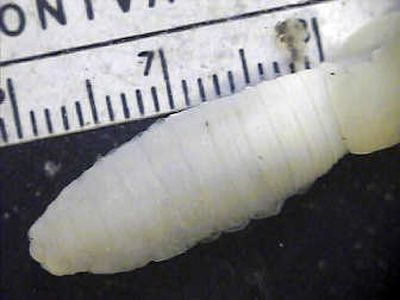Worm may not be unique to Palouse

Parts of an earthworm found near the Cascade mountain town of Leavenworth have challenged scientists’ contentions that a unique, 3-foot-long species lives only in the Palouse region of Washington and Idaho.
Jodi Johnson-Maynard, a University of Idaho associate professor and soil scientist, said Friday the remains of earthworms found near Leavenworth and Moscow, Idaho, are likely Driloleirus americanus, or the giant Palouse earthworm.
The recent discoveries are only the seventh time one of the elusive creatures has been found since the 1970s. All but two have been found in the Palouse.
Once thought to be plentiful under the native Palouse prairie, where the pale white earthworms reportedly grew to 3 feet long, only chopped-up remnants of a foot or less have been found in recent decades. Scientists think it may secrete a lily-scented mucus to discourage predators.
The fragments found in Leavenworth and Moscow lacked the internal structures required to determine the exact species, Johnson-Maynard said.
“We struck out,” she said, adding that expeditions are being organized to try to find whole specimens near where the fragments were found.
“We are going to resample those sites. We’re hoping to collect intact specimens for identification,” she said. “It is often the case with soft-bodied organisms that they do get damaged.”
Environmental groups sued the government in January to overturn a U.S. Fish and Wildlife Service finding that the giant earthworm does not merit Endangered Species Act protection, despite numbers that suggest it may be close to extinction.
Most earthworms found in Northwest gardens and lawns originated in Europe, arriving on plants or in soil shipped to the New World. Very few worms found in the Northwest are native species.
The most recent remains of what is likely a Palouse earthworm were found in Palouse prairie remnants on the Paradise Ridge farm of Wayne and Jacie Jensen south of Moscow in early March.
“It was no surprise to us that they found the worm there,” Jacie Jensen said. “It’s an intact, functioning ecosystem of Palouse plants, so the worm was where it should be.”
The discovery of a native earthworm on private property near Leavenworth challenges the giant worm’s Palouse name. A worm expert found what is believed to be a member of the species near Ellensburg in central Washington in 2000.
Lee Matthews, a Seattle resident who owns 20 acres of Ponderosa pine forest near Leavenworth, sent portions of a large worm he found last November to Johnson-Maynard.
Matthews said he has found dozens of large white earthworms through the years in the spring or fall when the soil is moist.
“It seems like I’ve found a couple a year since I bought the property in 1991,” Matthews said in a statement released by the University of Idaho.